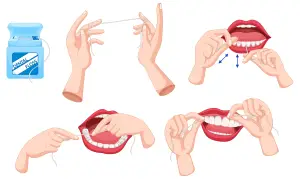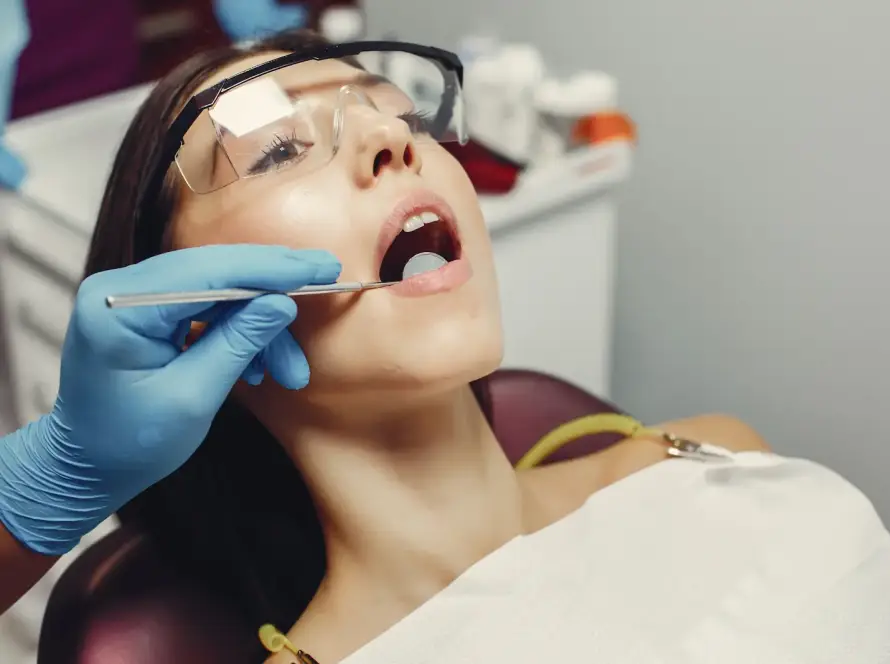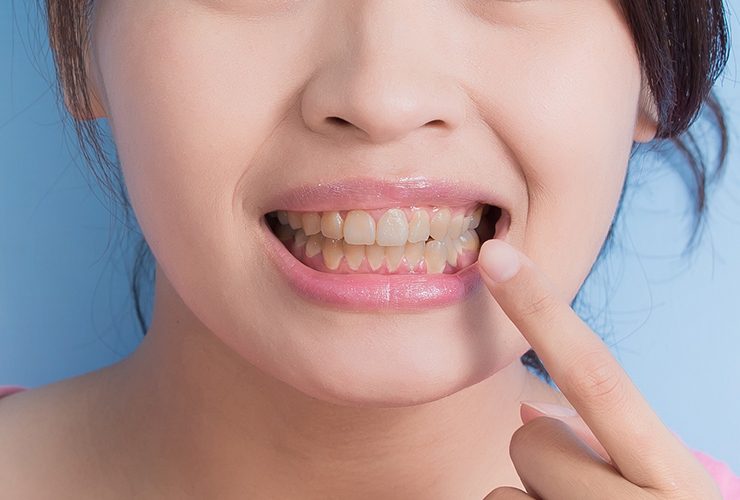The Importance of Dental Flossing
Dental flossing is a crucial aspect of maintaining good oral health. It plays a vital role in removing plaque and food particles that brushing alone cannot reach. Here are a few key reasons why dental flossing is essential:
- Prevents gum disease: Regular flossing helps remove plaque, a sticky film of bacteria that forms on teeth. If left unchecked, plaque can harden into tartar, leading to gum disease. Flossing helps keep your gums healthy by removing plaque and preventing its buildup.
- Reduces the risk of cavities: Flossing between teeth removes food particles that can get trapped, providing a breeding ground for bacteria. By removing these particles, flossing helps prevent the formation of cavities and tooth decay.
- Protects against bad breath: Food particles stuck between teeth can contribute to bad breath. Flossing removes these particles, helping to keep your breath fresh and your mouth clean.
- Promotes overall well-being: Poor oral health has been linked to various systemic health conditions like heart disease, diabetes, and respiratory problems. By flossing regularly, you reduce the risk of these health issues and promote your overall well-being.
- Preserves your smile: Regular flossing, along with brushing and professional cleanings, helps maintain healthy teeth and gums. By protecting your oral health, you can enjoy a beautiful smile for years to come.
In conclusion, dental flossing is a simple yet essential practice for maintaining optimal oral health. By incorporating flossing into your daily routine, you can prevent gum disease, cavities, bad breath, and promote your overall well-being. Take the time to floss regularly and reap the benefits of a healthy and confident smile.
Understanding the Benefits of Dental Floss
- Promotes Oral Hygiene: Dental floss is an essential tool for maintaining good oral hygiene. It enables individuals to remove plaque and food particles that are difficult to reach with a toothbrush. By flossing regularly, one can prevent the buildup of harmful bacteria and reduce the risk of gum disease and tooth decay.
- Prevents Gum Disease: Flossing plays a crucial role in preventing gum disease. When plaque accumulates between the teeth and along the gumline, it can lead to inflammation and infection. Regular flossing helps remove these plaque deposits, keeping the gums healthy and reducing the likelihood of gum disease.
- Reduces Bad Breath: Flossing not only removes food particles but also eliminates the bacteria that cause bad breath. By reaching areas where toothbrush bristles cannot, dental floss effectively removes bacteria and debris, leaving the mouth feeling fresh and odor-free.
- Preserves Tooth Enamel: Flossing helps preserve the integrity of tooth enamel. When plaque is left to accumulate, it produces acids that can erode the enamel, leading to cavities. By flossing daily, individuals can prevent plaque buildup and protect their tooth enamel from damage.
- Improves Overall Health: Maintaining good oral health through regular flossing has been linked to improved overall health. Studies have suggested possible associations between gum disease and other health conditions such as heart disease, diabetes, and respiratory infections. By flossing, one can potentially reduce the risk of these systemic health problems.
In summary, understanding the benefits of dental floss is crucial for maintaining optimal oral health. Flossing helps promote oral hygiene, prevent gum disease, reduce bad breath, preserve tooth enamel, and improve overall health. Incorporating flossing into a daily oral care routine is a simple yet effective way to achieve a healthy and beautiful smile.
How to Properly Use Dental Floss
Using dental floss is an essential part of maintaining good dental health. To ensure that you get the most out of your flossing routine, it is important to use dental floss correctly. Here are some tips on how to properly use dental floss:

- Start with enough floss: Begin by cutting off approximately 18 to 24 inches of dental floss. This length is sufficient to allow you to use a fresh section of floss for each tooth.
- Hold the floss correctly: Hold the floss tightly between your thumbs and index fingers. Leave a small section of floss, about an inch or two, for flossing.
- Maneuver around your teeth: Gently slide the floss between two teeth, using a back and forth motion. Avoid snapping the floss into your gums, as this can cause irritation.
- Curve the floss: As you move the floss against the side of each tooth, curve it into a “C” shape. This will ensure that you reach below the gum line, where plaque and debris can accumulate.
- Clean both sides of each tooth: Move the floss up and down against the side of each tooth, cleaning both the front and back surfaces. Take care to floss all the way down to the gum line.
- Use a fresh section of floss: After flossing each tooth, use a clean section of floss for the next tooth. Using the same section of floss can spread bacteria and debris from one tooth to another.
- Rinse your mouth: Once you have finished flossing, rinse your mouth thoroughly with water or mouthwash. This will help to remove any loosened plaque or debris.
By following these steps, you can ensure that you are using dental floss correctly and effectively. Incorporating regular flossing into your oral hygiene routine is crucial for maintaining healthy teeth and gums.
Different Types of Dental Floss
When it comes to choosing the right dental floss, there are several options available on the market. Each type of dental floss has its own unique features and benefits. Here are some different types of dental floss to consider:
- Nylon floss: This is the most common type of dental floss. It is made of nylon filaments that are twisted together to form a strong and flexible thread. Nylon floss is available in various thicknesses, such as waxed or unwaxed, and flavored or unflavored options. It effectively removes plaque and food particles from between the teeth.
- PTFE floss: PTFE (polytetrafluoroethylene) floss, also known as “glide” floss, is made from a high-tech material that slides easily between the teeth. It is resistant to shredding and is gentle on gums. PTFE floss is a good option for people with sensitive gums or tight spaces between their teeth.
- Waxed floss: Waxed floss is coated with a thin layer of wax, which helps it slide more easily between teeth. The wax coating makes this type of floss less likely to shred or break. Waxed floss is a popular choice for individuals who have crowded or closely spaced teeth.
- Unwaxed floss: Unwaxed floss does not have a coating, and it is thinner than waxed floss. It is a good option for individuals who have larger gaps between their teeth, as it can fit into tight spaces more easily. However, unwaxed floss may be more prone to shredding.
- Flavored floss: For individuals who enjoy a fresh taste when flossing, there are flavored floss options available. These flosses come in a variety of flavors, such as mint, cinnamon, or bubblegum, making the flossing experience more pleasant.
- Floss picks: Floss picks are small plastic devices that have a short piece of floss stretched between two prongs. They are convenient to use and can be helpful for individuals who have difficulty reaching certain areas of their mouth. Floss picks are available in different flavors and can be a good option for on-the-go flossing.
Remember, the most important thing is to choose a dental floss that you are comfortable using and that effectively removes plaque and food debris from between your teeth. It is advisable to consult with your dentist or dental hygienist to determine which type of dental floss would be best suited for your specific needs.
Common Misconceptions About Dental Floss
- Flossing is only necessary if you have food stuck between your teeth.
- Contrary to popular belief, flossing is not just about removing visible food particles. It helps eliminate plaque and bacteria that cannot be reached by toothbrushes alone. Regular flossing is crucial for maintaining oral hygiene and preventing dental issues like cavities and gum disease.
- Flossing makes your gums bleed, so it should be avoided.
- Bleeding gums during flossing indicate the presence of gum disease or gingivitis. Avoiding flossing can worsen the condition. Regular flossing, along with proper brushing techniques, can help heal and strengthen your gums over time, reducing bleeding.
- Using a toothpick or interdental brush can replace flossing.
- While toothpicks and interdental brushes can be useful for removing larger food particles, they cannot effectively clean plaque from tight spaces between teeth. Dental floss is the most effective tool for reaching those inaccessible areas and preventing the buildup of plaque and tartar.
- You don’t need to floss if you have dental implants or braces.
- If you have dental implants or braces, it becomes even more crucial to floss regularly. These dental appliances create additional spaces where food particles and plaque can accumulate, leading to tooth decay and gum problems. Consult your dentist for the proper flossing techniques for these specific situations.
- Flossing can cause gaps between the teeth.
- Flossing, when done correctly, does not cause gaps between teeth. In fact, it helps maintain gum health and prevents the development of issues that could lead to tooth loss and wider spaces between teeth. If you notice gaps, consult your dentist, as they may indicate underlying dental issues.
- Flossing is time-consuming and inconvenient.
- Flossing should ideally be an essential part of your daily oral hygiene routine. With practice, it can be performed quickly and efficiently. The benefits of regular flossing far outweigh the few extra minutes it takes, helping you maintain a healthy smile and prevent costly dental problems in the long run.
Remember, dental floss is a crucial tool for maintaining optimal oral health. By debunking these common misconceptions, you can understand the importance of flossing and make it an integral part of your daily dental care routine.
The Connection Between Dental Floss and Gum Disease
Gum disease, also known as periodontal disease, is a common oral health problem that affects millions of people worldwide. It is caused by the buildup of plaque and tartar on the teeth, which can lead to inflammation and infection of the gums. One of the most effective ways to prevent gum disease is by incorporating dental floss into your daily oral hygiene routine.
Regular flossing plays a crucial role in removing plaque and food particles that get stuck between the teeth and along the gumline. These areas are difficult to reach with a toothbrush alone. By flossing, you can effectively remove this debris, preventing the formation of plaque and reducing the risk of gum disease.
Research has shown that individuals who floss daily are less likely to develop gum disease compared to those who do not. Flossing not only helps remove plaque but also stimulates the gums and promotes blood circulation, which can contribute to healthier gum tissue.
Moreover, gum disease is often linked to more serious health problems, including heart disease, diabetes, and respiratory infections. By keeping your gums healthy through regular flossing, you can potentially reduce the risk of developing these systemic conditions.
It’s important to note that proper flossing technique is essential for optimal oral health. Be sure to use a fresh section of floss for each tooth and gently glide it up and down along the sides of the teeth, making a C-shape to reach below the gumline. If you experience bleeding or discomfort while flossing, consult your dentist as this could be a sign of gum disease or another underlying oral health issue.
In conclusion, the connection between dental floss and gum disease is clear. Flossing plays a vital role in removing plaque, preventing gum inflammation, and maintaining healthy gums. Make it a habit to floss daily along with regular brushing and dental visits to ensure the best possible oral health and prevent gum disease.
Dental Flossing Techniques for Different Types of Teeth
Proper dental flossing techniques can vary depending on the type of teeth you have. Here are some techniques to consider based on your specific dental needs:
- Standard Teeth: For those with standard, evenly spaced teeth, the traditional flossing technique is suitable. Take a piece of floss, around 18 inches long, and wrap it around your fingers. Gently slide the floss between each tooth, forming a C-shape around the tooth and moving it up and down to remove plaque and food debris.
- Tight Teeth: If you have tight teeth with minimal gaps, using a waxed floss or a thinner floss can be more effective. Carefully guide the floss between the close spaces, making sure to be gentle to avoid gum irritation.
- Gapped Teeth: Gapped teeth require a different approach to ensure thorough cleaning. Consider using a dental floss threader, which helps navigate the floss through the gap. Alternatively, interdental brushes can be useful for cleaning between the gaps.
- Braces or Dental Appliances: Flossing with braces or dental appliances can be challenging. Using a floss threader or orthodontic floss can help guide the floss under the wires and around the brackets. Super floss, which has a stiff end, can also be useful in navigating around dental appliances.
- Sensitive Gums: If you have sensitive gums, opt for a soft, spongy floss or a water flosser. These alternatives can provide effective cleaning while minimizing irritation to the gums.
Remember, regardless of the type of teeth you have, it’s essential to floss at least once a day and practice proper technique to maintain optimal oral health. If you’re unsure about the best flossing method for your specific dental needs, consult your dentist or dental hygienist for personalized guidance.
Incorporating Dental Flossing into Your Daily Routine
- Make it a Habit: Incorporating dental flossing into your daily routine is crucial for maintaining optimal dental health. It is recommended to floss at least once a day, preferably before bedtime. By making flossing a habit, you ensure that you consistently remove plaque and food particles from between your teeth.
- Choose the Right Floss: There are different types of dental floss available, such as waxed, unwaxed, flavored, and tape floss. Experiment with different options to find the one that suits you best. Whether you prefer traditional floss, floss picks, or water flossers, the key is to use a product that you are comfortable with and that effectively cleans between your teeth.
- Proper Technique: To get the most out of flossing, it’s essential to use the correct technique. Start by taking around 18 inches of floss and wrap it around your middle fingers, leaving a small section to work with. Gently slide the floss between each tooth, making sure to reach below the gumline. Curve the floss into a C shape against the side of each tooth, and move it back and forth to remove plaque and debris. Repeat this process for each tooth, including the back molars.
- Be Gentle: While it’s important to be thorough, it’s equally important to be gentle while flossing. Avoid snapping the floss against your gums, as this can cause irritation or even bleeding. Use a gentle back-and-forth motion and take care not to force the floss, as it can damage the delicate gum tissue.
- Time-Saving Tips: If you find it challenging to allocate time for flossing, try incorporating it into your existing routine. For example, you can floss while watching television or listening to music. Additionally, using floss picks or water flossers can be more convenient and time-saving options for some individuals.
Incorporating dental flossing into your daily oral hygiene routine is an essential step towards maintaining a healthy smile. By committing to regular flossing and following proper techniques, you can effectively remove plaque, prevent gum disease, and promote overall dental health.
The Role of Dental Floss in Preventing Bad Breath
- Removes Food Debris: Dental floss is an effective tool in removing food debris that gets stuck between teeth. These food particles can contribute to the buildup of plaque and bacteria, which are major culprits of bad breath. By using dental floss regularly, one can remove these particles and prevent their decomposition, thereby reducing the risk of bad breath.
- Reduces Plaque Formation: Dental flossing helps in removing plaque, a sticky film of bacteria that forms on the teeth. When left unchecked, plaque can lead to tooth decay, gum disease, and unpleasant breath odors. By flossing regularly, individuals can prevent the accumulation of plaque, keeping their breath fresh and their oral health in good condition.
- Stimulates Gum Health: Flossing not only cleans between the teeth but also reaches the gum line, stimulating the gums and promoting their health. Gum disease, characterized by inflamed and bleeding gums, can be a significant cause of bad breath. By flossing, individuals can remove bacteria and food particles from the gum line, reducing the risk of gum disease and associated bad breath.
- Accesses Hard-to-Reach Areas: Toothbrushes may not effectively reach certain areas between teeth, especially those with tight spaces or dental work like braces or bridges. In such cases, dental floss becomes essential for removing trapped debris and bacteria. By flossing in these hard-to-reach areas, one can maintain cleanliness and freshness, thereby preventing bad breath.
- Enhances Overall Oral Hygiene: Dental flossing complements regular brushing by providing comprehensive oral care. While brushing cleans the surfaces of teeth, flossing targets the spaces that a toothbrush cannot easily reach. So, incorporating flossing into a daily oral hygiene routine is vital for achieving optimal oral health and preventing bad breath.
In summary, dental floss plays a significant role in preventing bad breath by removing food debris, reducing plaque formation, stimulating gum health, accessing hard-to-reach areas, and enhancing overall oral hygiene. By incorporating flossing into their daily routine, individuals can maintain freshness, minimize the risk of dental problems, and enjoy a healthy, pleasant breath.
The Future of Dental Floss and Oral Health
- Technological advancements in dental floss:
- The future of dental floss looks promising with continuous technological advancements. Companies are investing in research and development to create innovative flossing tools that provide better oral health outcomes.
- Electric and water flossers have already gained popularity due to their convenience and effectiveness. These tools use pulsating water or vibrations to remove plaque and debris, making flossing easier for many people.
- Biodegradable and eco-friendly options:
- As sustainability becomes increasingly important, the dental industry is also focusing on creating biodegradable and eco-friendly floss options. Traditional flosses are typically made from nylon or polyester, which are not environmentally friendly. However, there are now alternatives available made from biodegradable materials such as silk or plant-based fibers.
- Improved effectiveness and ease of use:
- The future of dental floss will likely include enhancements that improve its effectiveness in cleaning between teeth. Advancements in floss design may include features like microfibers or specialized coatings that effectively remove plaque and debris, leading to better oral hygiene.
- Additionally, flossing tools may become even more user-friendly, with ergonomic designs and enhanced maneuverability, making the process more comfortable and efficient for individuals of all ages.
- Integration of smart technology:
- The rise of smart technology has the potential to revolutionize oral healthcare, and dental floss is no exception. We may see the integration of sensors or cameras into flossing tools that can provide real-time feedback on the cleanliness of one’s teeth and gums.
- Smart flossing tools could track flossing habits, monitor oral health indicators, and provide personalized recommendations for improved oral hygiene routines. This integration of technology could greatly benefit individuals in maintaining optimal oral health.
Overall, the future of dental floss appears promising with advancements in technology, eco-friendly options, enhanced effectiveness, and the integration of smart technology. These developments aim to make flossing more convenient, effective, and enjoyable, leading to improved oral health for individuals worldwide.














